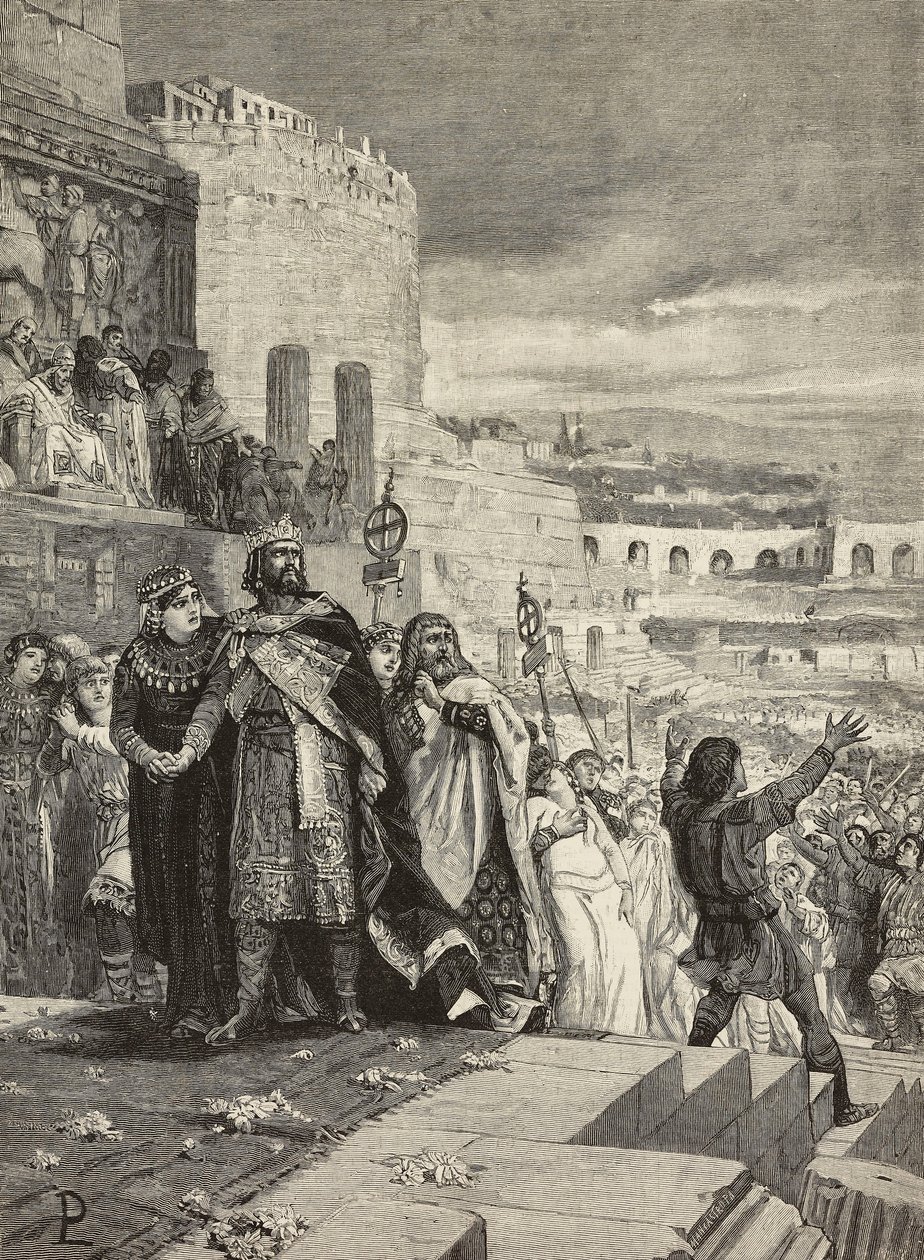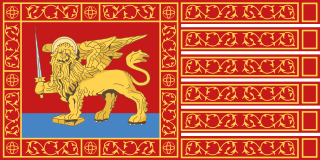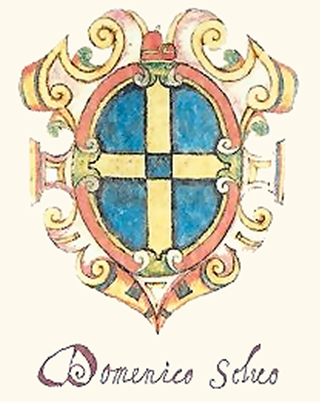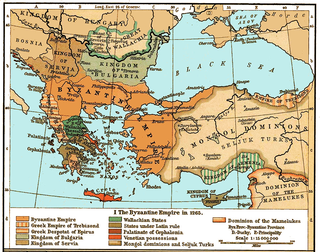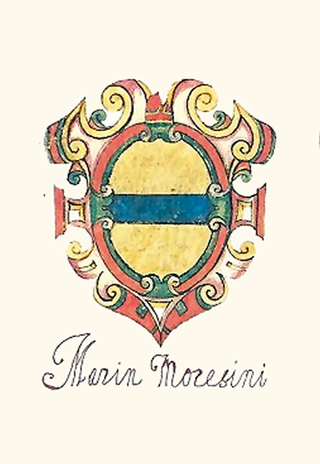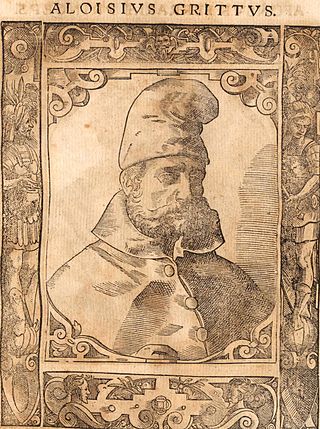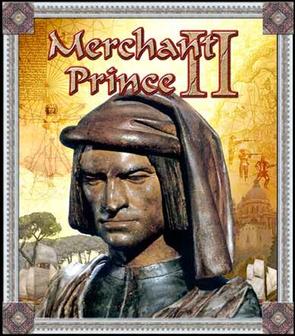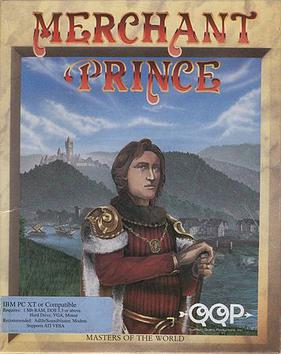Gameplay
Players choose a family crest and surname rather than an individual name. [9] Play begins in AD 1300 and can last (in the first two titles) as late as 1492, the year of Columbus's rediscovery of the Americas. The default map covers all of Afro-Eurasia and permits the rounding of the Cape of Good Hope but not the North Cape. This can be replaced by randomized maps with variable amounts of ocean, forest, desert, &c. [10] The game is won by the first player to acquire a million florins or by the player with the highest net worth at game's end. [11]
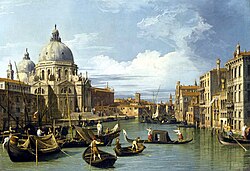
Venice
The player competes with three other families—either other humans or AIs of variable difficulty [12] —to be the most successful clan in Venice. Opponents may be negotiated or allied with, aided, or threatened. [13] The Council of Ten may all be bribed into service, [14] allowing the player to be appointed as Venice's council head, general, admiral, or minister of construction. A family may only hold one office at a time, but any family with a senator must receive a post. Funds may be well-used or embezzled; [15] [6] those without access to the city's army may still hire large mercenary forces at the Campanile. [16] The council head receives no funds but may try senators for treason. Support from a majority of the council at the decennial election allows one to hold the office of doge, controlling other appointments and Venice's taxation. [17] Popularity can be improved by donations to the church, by throwing lavish masquerades, or by funding major works of sculpture, painting, and architecture. [18] Defeating brigands and pirates in battle is also well received. [19] The wealthiest families may purchase ecclesiastical benefices, providing income and influence in the college of cardinals. Enough influence at a conclave gives a player control over the papacy itself. Popes may embezzle church funds, "excommunicate" (i.e., place an interdict upon) Christian cities, and gather crusading armies. [20] In some games, overindulgence in indulgences provokes an earlier Reformation, turning northern cities against Italy and its traders. [21] Direct attacks against friendly cities or fellow Venetians, when proven, is highly unpopular and must be compensated through fines. For the devious, impatient, or wrathful, "den of iniquities" permits players to burn others' warehouses and homes, destroy reputations with rumormongering, [n 3] or to assassinate senators, cardinals, doges, and popes. [25] Being tied to the act can destroy one's reputation, but other players can be framed as well. [26] [27]

Exploration
The map the player receives from uncle Niccolo resembles those of the period: it is highly accurate close to Venice but grows much less so the further one goes. The mechanic has been praised by reviewers: [28] "Though its gameplay was nowhere near as sophisticated as that of its near contemporary Civilization , Merchant Prince/Machiavelli did a better job of capturing what exploring is really like. Very rarely in the human experience are people pushing into an entirely blank unknown space. There are always rumors, always guesses, always some advice either from locals or past chronicles." [29]

The player must send out trade or military units to explore the world, facing pirates, brigands, and storms at sea and in the desert, [30] or negotiate with the other families to purchase more accurate maps from them. Many cities are initially closed to foreign traders and their leaders must be bribed or forcibly removed to open them to trade. Defeating a city with Venice's armed forces or one's own mercenaries permits one to control it (closing it to rivals) or to negotiate its status as a freeport (left open to rivals but providing a large boost to popularity). [19] The time and effort exploration takes is somewhat compensated by the occasional discovery of extremely valuable relics—such as a head of John the Baptist—that are sold to the cathedral at Venice. [31] [27]
Trade
In addition to uncle Niccolo's stipend, [32] the player can earn income from indulgences [33] and government offices. [15] Ultimately, the most profitable course is to begin trading various commodities among the world's major cities. [34] [4] [6] Trade is possible via small or large galleys (fast and nimble but frail in storms), small or large cogs (slow and unable to use small rivers but resistant to storms at sea), donkey teams (resistant to rockslides), or camel caravans (resistant to sandstorms). [35] Up to 15 units may be purchased and used together. [36] The commodities include Venetian glass, French wine (as "grog"), relics from the Holy Land, [23] African gold and ivory, Chinese silk, [37] and Indonesian spices, [7] [n 4] though not salt or slaves. The cities include major centers such as Venice and Khanbaliq (misspelled "Kahnbalig"), [4] along with oddities like Antioch and imaginary locales like Shangri-La (as "Xiangrala"). [4] [n 5] Depending on the difficulty level, brigandry and piracy may be rampant and each successful attack makes them stronger still. [38] Guards may be hired to deal with them but can be quite expensive and, if unpaid, will turn to brigandage. [39] Goods become extremely valuable in times of crisis: during interdicts from the pope (driving away pious traders), outbreaks of plague (which usually begin a decade or two into the game), and wartime. [40] Trading under such conditions can be highly profitable but risky: plague may destroy one's trading units and they may be attacked by rival or renegade armies. [27] All three games support automated trading routes, [41] although the path selection and bugginess varies among the versions.

History
The games begin in the year 1300. The default is for them to end in AD 1400, but they may be set to end after 15, 30, 60, 150, or 192 years as well. [10] The manual includes an overview and glossary of this period [42] and incorporates aspects of the era both directly and through game mechanics. The Venetian–Genoese Wars, corsairs, [21] Black Plague, condottieri, and indulgences appear [43] and the players' actions may instigate an early Reformation, [21] recreate the ignoble Fourth Crusade, or mirror the struggles of the Medicis, travels of Marco Polo, or precepts of Machiavelli. [42] On historical maps, the rounding of Africa and assaults on Turkey, Persia, and India may be achieved by the players or AI ahead of the Portuguese, but there is no effect on the prosperity of Venice. The Hundred Years' War, Turco-Venetian wars, and Tatar invasions appear in minor form. [21] Game mechanics push players into adopting a coasting trade for galleys, large caravans and convoys for important routes, and working for the good of all Venetians in public while covertly bribing officials and sabotaging rivals. [44]
Numerous items, however, are simplified: the doges were appointed for life but the Ten served only one-year terms and could only have a single family member serving at a time. The Republic of Venice maintained its allegiance to Rome throughout the Western Schism but the earlier Avignon Papacy goes unmentioned. Cities only occasionally and randomly close themselves to trade. Florence is treated as a seaport in place of Pisa and Constantinople is given its earlier and terser name Byzantium.
Merchant Prince II included a few cut scenes and five new scenarios in addition to Afro-Eurasia and the random map generator. They were the Hanse (the Hanseatic League in the North and Baltic seas), the Mediterranean (a Venetian family), the Orient (a Shanghainese trader in the Far East), Marco Polo (along the Silk Road), and a fantasy treatment of Atlantis [7] (represented as a single island city in the Atlantic). [45] The scenarios were not differentiated apart from their maps, however: players continued to see Venetian gondolas and St Mark's in "Atlantis" and "compete[d] to become the Doge of China or the Pope of Asia". [6]

